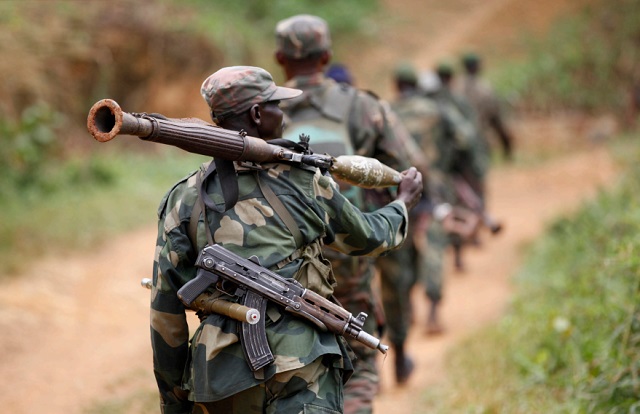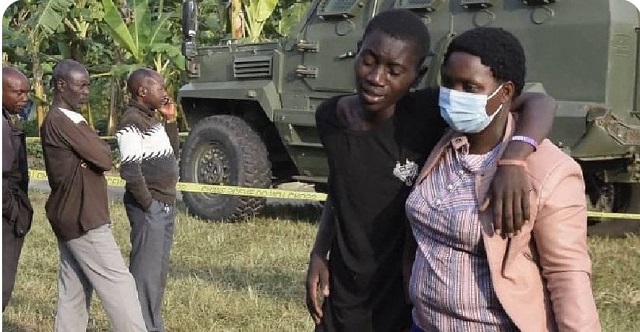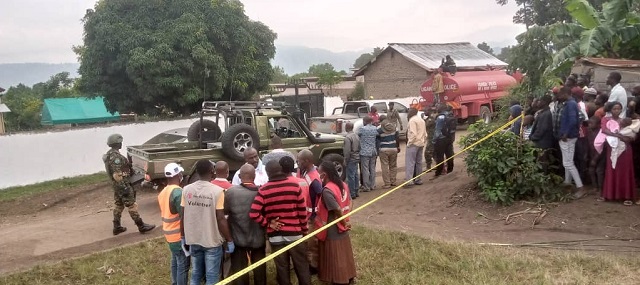
Terror group’s new funding, wider networks exposed
COVER STORY | IAN KATUSIIME | A well-orchestrated attack on Lhubiriha Secondary School in Kasese District on June 16 that left 43 people dead; 37 of whom were students, has left the nation in shock and agony.
The government has pinned the notorious Allied Democratic Forces (ADF) for the attack on the school, where helpless boys and girls in dormitories were hacked, firebombed and killed.
But rather than be seen as an isolated incident, the attack on Mpondwe, is a sign of ADF resurgence in the Beni region on the DR Congo side spilling over to Mpondwe on the Ugandan side.
Before the attack on the school, the ADF is suspected to have been behind two major attacks on towns in Beni territory, just a few kilometers away, on the DR Congo side.
The ADF killed nine civilians in the village of Kasindi in Beni territory on June 11. The assailants wounded three civilians and abducted another civilian. This area is less than 20 minutes drive from Mpondwe border. The ADF attacked it on Sunday and attacked Lhubiriha Secondary School in Mpondwe on Friday of same week.
The ADF is also suspected to have been behind the killing of 12 civilians in the village of Bukokoma in Beni territory on June 08. The assailants wounded another two other civilians.
As a measure of increased activity in the Beni territory, reports by the Kivu Security Tracker (KST) indicate that 74 civilians were killed in May compared with 47 in April. The DR Congo army FARDC troops killed up to 10 ADF fighters close to Halungupa in Beni territory on May 9.
The KST says the ADF has perpetrated a series of killings close to Biakato in Mambasa territory, an area in which the ADF have never been present until now. The KST says ADF killings in the region are out of control.
“They therefore appear to be pursuing retaliation against civilians and growing their area of operations – a process ongoing since the start of the large-scale operations against them, launched in October 2019,” says KST.
President Museveni on June 17 ordered more troops into the Democratic Republic of Congo (DRC) to pursue the ADF.
Museveni says the Uganda army in DR Congo had initially concentrated on the bigger groups, west of the Rwenzori. After defeating the bigger groups, recently, they started hunting the smaller group, south of the Rwenzori Mountain, south of the Kasindi-Beni road, in the Mwalika valley, around Virunga National Park in DR Congo, and opposite Lake Edward in Rutshuru and Butuumbi. He said the UPDF killed an ADF commander and Quarter Master in April.
“Hence, the desperate, cowardly, terrorist act of attacking a school,” he said.
Coming just days after the government dropped war crimes charges in a seven-year case against the Rwenzori sub-region’s cultural leader Omusinga Charles Mumbere and hundreds of royal guards, the night massacre at Lhubiriha Secondary School has left a sense of short-lived glory.
It has caused unrest and displacement as residents of Bwera town in Kasese District have abandoned their homes in search of safety in spite of the area where the attack happened, being one of the most fortified in the country.
Scenes of fleeing families on foot with young children, some latched onto boda bodas and others loading what they can on trucks brought back memories of 2016 when the UPDF stormed the Rwenzururu palace and killed more than 100 royal guards.
Omusinga Mumbere was allegedly fomenting the formation of a breakaway entity from Uganda for his Rwenzururu kingdom that would be called Yiira Republic.
Security lapses
The government’s pinning of the ADF harks back to when the ADF raided Uganda Technical College Kichwamba, farther north in the same Rwenzori sub-region and burnt 80 students to death and abducted 100 others in 1998 in the first major attack by the rebel group on Uganda.
According to a Human Rights Watch Report of June 10, 1988, the ADF rebels who made the raid numbered between 200 and 300 and set three dorms on fire.
Twenty five years later, the scenes are playing out in more macabre fashion. The assailants this time were a much smaller group, signaling their adaptation in the face of an onslaught from the UPDF. According to survivors, the militants were about six-wielding machetes and spared no time in killing the students. Julius Isingoma, a student who was interviewed by journalists, says the assailants recorded their acts on smart phones as they also set the dorm ablaze.

Residents of Kasese are now in bewilderment as to how they could have come under such a deadly attack from suspected rebels in spite of the presence of a Police Division 1km away, a UPDF detachment 2km away, and Muhoti Barracks in Fort Portal on top of the UPDF Mountain Division to oversee the region.
Muhoti Barracks, created in 2021, is home to the 333 Mountain Brigade that is tasked with security of the Rwenzori sub region. Brigade 111 is currently in North Kivu as it is was deployed to neighbouring DR Congo in search of ADF militants in 2021 under Operation Shujaa.
The major security lapse has left the public wondering how the army and other security agencies could have dropped the guard at a sensitive time when the Omusinga Mumbere was returning to his dominion after seven years in detention.
The public has raised questions, demanding for accountability from a well facilitated defence sector which in the next financial year has a classified budget totalling Shs2trillion. The classified expenditure has usually been a fig leaf for intelligence operations and high grade defence equipment, only known to the highest authorities in the State.
Police has arrested 20 suspects in connection with the attack, including the headteacher and staff at Lhubiriha SS, but skepticism remains among the public who perceive a major security lapse as the main cause of the attack. Many are questioning why the omission of area heads of security have not been highlighted, and the offenders arraigned.
Omusinga Mumbere, a heroic figure in the Rwenzori, whose return has now been overshadowed by the grisly killings, has demanded for answers from the government that charged him with terrorism.
Mumbere returned to his kingdom on June 14 to a rousing welcome after the government dropped charges of treason and terrorism he was facing since 2016.
“I hear there are lot of security installations along the border. I hear there is an army detachment two kilometres from the school. Why would they not hear the bullets? I also hear that a grenade was detonated at the school,” Mumbere was quoted by journalists.
“Rwenzori region, when shall we see mass killing stopping in this area,” Mumbere further asked.
President Museveni has asked similar questions as well.
“Was an alarm sounded and by whom? How did the nearby security people respond? Why didn’t our people on the Congo side have intelligence on this splinter group etc.?” President Museveni asked.
Since launching Operation Shujaa, a Uganda army offensive against the ADF two and half year ago, Museveni and UPDF commanders have been chest thumping and dismissive of it as a defeated militia.
President Museveni’s statement after the attack reflected as much. He said since the UPDF now has the DR Congo government’s permission to operate on its territory which serve as the ADF’s rear base for operations in Uganda, “we have no excuse in not hunting down the ADF terrorists into extinction.”
In a major sign that ADF is far from defeated, Brig. Dick Olum, the Operation Shujaa Commander, was forced to rush back from DRC to Kasese after the terrorist incident.
Now the army top-brass, including the Chief of Defence Forces Gen. Wilson Mbadi and the Commander of the Land Forces, Lt. Gen. Kayanja Muhanga, are camped in the area to deal with the aftermath of the school attack.
Terror funding networks
As the country struggles to deal with the unexpected resurgence of ADF, a new paper published in June titled Fatal Transaction: The Funding behind the Islamic State’s Central Africa Province by researchers at George Washington University, U.S. details how the ADF has become a significant regional threat.
The paper is produced by the university’s Program on Extremism and relied on local partners in Uganda, DRC, Kenya, and Somalia in a multi-year investigation. It notes that “the ADF not only overcame the loss of its previous funding streams precipitated by the arrest of its former leader Jamil Mukulu in 2015, but also expanded its operations in East and Central Africa.”
The fortunes of ADF, which has since rebranded to Islamic State’s Central Africa Province (ISCAP), began changing when it started receiving financial transfers from the Islamic State in 2017.
Jamil Mukulu was in 2015 sniffed from his hideout in Tanzania and whisked to jail in Uganda where he is on trial on multiple charges of terrorism and murder.
Rather than weaken ADF, Mukulu’s arrest appears to have opened new windows for ADF under ISCAP, a bigger operation that has spread its wings to countries like Kenya, Tanzania, Somalia, Mozambique, South Africa and United Arab Emirates.
According to the report, Somalia and South Africa are the major financing hubs of ISCAP.

“Testimony from ISCAP defectors and corresponding financial transfer receipts indicate that there are multiple Islamic State financial networks emanating out of Somalia and South Africa. While some of these have yet to be fully understood, an in-depth exploration of one of the networks can shed light on the current regional coordination of financing.”
It added that money generated by the Islamic State in both Somalia and South Africa is often pooled inside South Africa and subsequently laundered across East Africa through an intricate network that finances the Islamic State’s activities in the DRC, Uganda, Tanzania, and Mozambique. It cited the method of consolidation and regional distribution as a standard model for Islamic State financing globally.
According to the paper, the cells in South Africa are loyal to the Islamic State and constitute another important hub in the financing of both ISCAP and the Islamic State in Mozambique. While not formally organised as one of the Islamic State’s so-called “provinces,” the cells in South Africa play an outsized role in the group’s revenue generation and coordination for central, eastern, and southern Africa, as well as local revenue generation for the Islamic State elsewhere.
“While their revenue-generating activities are significant, the most important role played by Islamic State-loyal cells in South Africa appears to be that of middlemen, consolidating funds from those provinces and support networks that are primarily focused on generating revenue, and transferring the money to the provinces that are mainly financing recipients.”
In the paper, the researchers stressed that since officially adopting the Islamic State’s moniker and identity as its Central Africa Province in 2019, ISCAP has “since become one of the Islamic State’s most active global branches, killing thousands and routinely featuring in the Islamic State’s centrally released propaganda. ISCAP’s current status as a significant regional threat is a testament to the power of the Islamic State’s money flowing into its coffers.”
The researchers said the funding from the global caliphate has had dire consequences. They point out that Islamic State money funded networks responsible for the 2021 bombing campaigns in Uganda and Congo and an attempted one in Rwanda. It lays out in detail how the funding streams have been operating to turn a once obscure group into a regional adversary to reckon with.
“Much of the money flowing to ISCAP has been sent to Uganda, where ISCAP’s networks receive the funds to use locally or smuggle across the border into Congo,” the paper says.
“These couriers then used the funds for local operations in Uganda or physically transported the money across the border into Congo, either carrying it themselves, or handing the funds off to other couriers.”
Rise of ADF kingpin Nkalubo
The paper mentions Meddie Nkalubo, a Ugandan who is well known to security and intelligence as an ADF kingpin. Nkalubo is said to be overseeing ISCAP’s financial networks and describes him as “a high-ranking Ugandan who joined the group around 2016 as an IT and media specialist and who helped facilitate the then-burgeoning relationship with the Islamic State.”
Nkalubo has since risen through the group’s ranks to “become its leader of external operations, overseeing from ISCAP’s jungle camps, a vast network of subordinates and collaborators across central, eastern, and even southern Africa.”
Nkalubo’s operatives have been trained to use the hawala system- a renowned transfer of money outside of the banking system usually used for illegal activities like money laundering, drug operations and other illicit activities. Nkalubo has been sanctioned by the European Union for his activities with the terror group and remains on the run.
He is mentioned 30 times in the paper and is said to be involved in the bomb incidents that rocked Uganda in 2021 including the one on a bus, at a pork eatery and at the attempt at the burial of fallen deputy Inspector General of Police Lt. Gen. Paul Lokech in Pader, northern Uganda.
According to the paper, Nkalubo’s lieutenants and couriers have built a vast network of operations that have facilitated ISCAP’s agenda in Uganda and surrounding areas.
Uganda has been a fertile recurring ground for ISCAP even when it was still known as ADF; a fringe shadowy element wrecking terror in Uganda. The paper’s insights present a major challenge to Uganda’s security apparatus who have treated the threat posed by ADF as a military one.
 The Independent Uganda: You get the Truth we Pay the Price
The Independent Uganda: You get the Truth we Pay the Price



